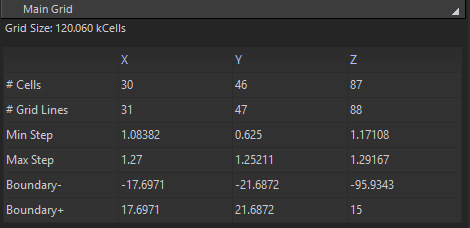How to get the bounding box of the computational domain of a given simulation from Python?
-
So I only know how to get the grid settings when the simulation already has results. Don't know if this is what you are looking for, but I'll post it anyway :)
import s4l_v1.document as doc import numpy as np #get all the simulations sims = list(doc.AllSimulations) #select a simulation here firstSim = sims[0] #get the results result_firstSim = firstSim.Results() result_firstSim = result_firstSim['Overall Field'] #get the grid settings GridData = result_firstSim[0] GridData.Update() GridData = GridData.Data.Grid #get the axis X = GridData.XAxis Y = GridData.YAxis Z = GridData.ZAxis #create the matrix that is shown in the options mene numGridLines = GridData.Dimensions numCells = np.array(numGridLines) -1 minStep = np.array([np.min(np.diff(X)),np.min(np.diff(Y)),np.min(np.diff(Z))])*1000 maxStep = np.array([np.max(np.diff(X)),np.max(np.diff(Y)),np.max(np.diff(Z))])*1000 boundaryMin = np.array([X[0],Y[0],Z[0]])*1000 boundaryPlus = np.array([X[-1],Y[-1],Z[-1]])*1000 MainGridOptionsArray = np.array([numCells,numGridLines,minStep,maxStep,boundaryMin,boundaryPlus])Maybe it is also possible to get this data without running the simulation.
-
I was indeed looking for a way to access this data before running the simulation (so that I can detect in advance that the simulation is likely to be very slow, or to fail, for this or that reason). So your solution does not yet solve my problem.
But thanks a lot for contributing: this piece of code will for sure end up being useful to someone!
-
one thing you could try is
import XCoreModeling as xcm # get the simulation sim = doc.AllSimulations[0] # get bounding box of everything in your simulation bounding_planes = xcm.GetBoundingBox(list(sim.AllComponents)) # returns a 2-tuple of Vec3 which give the opposite corners of the bounding box # get the padding added by the grid settings grid_settings = sim.GlobalGridSettings for xyz in range(3): grid_bounds[0][xyz] -= grid_settings.BottomPadding[xyz] grid_bounds[1][xyz] += grid_settings.TopPadding[xyz]This should be accessible once the simulation has been set up, but before it has been run. Hope this helps!
-
one thing you could try is
import XCoreModeling as xcm # get the simulation sim = doc.AllSimulations[0] # get bounding box of everything in your simulation bounding_planes = xcm.GetBoundingBox(list(sim.AllComponents)) # returns a 2-tuple of Vec3 which give the opposite corners of the bounding box # get the padding added by the grid settings grid_settings = sim.GlobalGridSettings for xyz in range(3): grid_bounds[0][xyz] -= grid_settings.BottomPadding[xyz] grid_bounds[1][xyz] += grid_settings.TopPadding[xyz]This should be accessible once the simulation has been set up, but before it has been run. Hope this helps!
